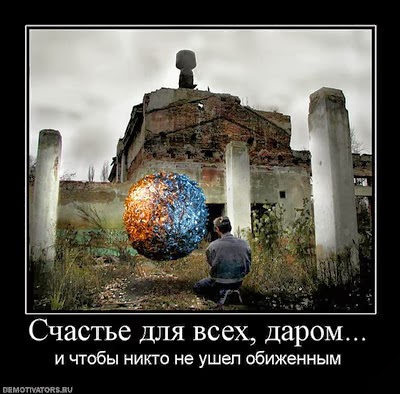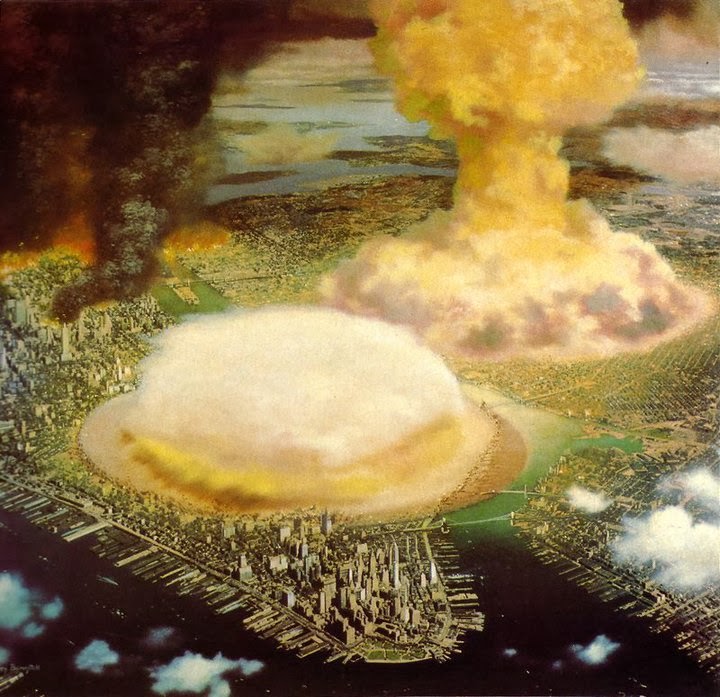giovedì 29 settembre 2011
Tomgram: Pepe Escobar, Will Asia Save Global Capitalism?
http://www.tomdispatch.com/blog/175445/tomgram%3A_pepe_escobar%2C_will_asia_save_global_capitalism_/
The Decline and Fall of Just About Everyone
"Ghadames:The Jewel of the Desert. The Pearl of the Sahara"
http://www.temehu.com/Cities_sites/Ghadames.htm#
[war compels one to study geography, to learn new names, social and political agencements, escape and invasion routes]
mercoledì 28 settembre 2011
martedì 27 settembre 2011
TOTAL PEACE – PURE WAR ["Paul Virilio", Ian James, Routledge 2007, 77-81]
TOTAL PEACE – PURE WAR
Perhaps one of the most startling conclusions that Virilio draws from his analysis in Bunker Archeology, one upon which he builds in subsequent works, is that the Second World War did not come to an end (Virilio 1994°: 58). The logic of total war is such that the state of war itself becomes limitless. Virilio draws this conclusion because he sees an essential continuity between the aerial bombing of European and Japanese cities and the threat of extermination posed to civilian populations by nuclear weapons in the post-war period. If the redundancy of frontier fortifications signals the advent of total war, then the advent of the nuclear bomb and the threat of extermination it implies inaugurates a period of what Virilio terms ‘Total Peace’. This continuity between the total war of aerial bombardment and the total peace of nuclear deterrence, and by implication the absence of any real distinction between war and peace in the post-war period, could be defended with simple reference to the actual use of nuclear weapons in Hiroshima and Nagasaki. The deployment of nuclear payloads was arguably a direct extension of the strategy of bombing urban centres which was already in place and, whilst the destruction of the two Japanese cities clearly brought hostilities between the Allied and Axis powers to a close, it was also the opening chapter of what came to be called the Cold War, that is, the nuclear stand-off between the United States and the Soviet Union.
For Virilio the Total Peace of nuclear deterrence is an inverted continuation of the total war of aerial bombardment, or as he puts it in an interview with Sylvère Lotringer, ‘the Second World War never ended . . . There’s no state of peace. It isn’t over because it continued in Total Peace, that is, in war pursued by other means’ (Virilio and Lotringer 1997: 30–1). Here Virilio inverts Clausewitz’s statement about war being a continuation of politics and transforms it into the following: ‘the Total Peace of deterrence is Total War pursued by other means’ (Virilio and Lotringer 1997: 31).
Looked at from this perspective the claim that the Second World War did not come to an end is perhaps not so startling, although it clearly recasts the question of what a ‘cold war’ might be in different terms. This argument is taken up by Virilio in the work published immediately after Bunker Archeology in 1976, entitled The Insecurity of Territory (L’Insécurité du territoire).
Once again he emphasizes the manner in which the Second World War can be seen as a transitional moment of decisive importance in the history of conflict and the political structures which are shaped by military space. Here he focuses again on the impact of aerial warfare: ‘Total war was a threshold for our civilization to the extent that it was the first global aerial war’ (Virilio 1993: 92).
The shift from total war to total peace needs to be understood quite specifically in the context of the technology of war, and the dialectic of attack and defence which, according to Virilio, provides the motor for the development of war technology. Here he suggests that the transition from total war to total peace is an implicit necessity of technological progress which will inevitably aim to increase the power, speed and penetration of weaponry: ‘Already, total war carried within it its technical self-surpassing, the Cold War then total peace’ (Virilio 1993: 133). Yet, however much aerial bombing and nuclear deterrence might seem very different from each other, Virilio argues that they bring about in reality the same state of affairs, that is, a generalized insecurity of civilian populations on the basis of which military strategy is pursued: ‘the principle of these successive strategies derives only from the creation and expansion of civil insecurity inside national frontiers, an insecurity which would have been inconceivable a few decades earlier’ (Virilio 1993: 133). The assertion that the Second World War did not come to an end is not simply an abstract redrawing of the distinction between war and peace. For Virilio the continuation of total war in the shape of total peace implies a very real lived insecurity on the part of civilian populations (as those who lived through this period may all readily testify). As was shown earlier, Virilio questions in more general terms the distinction between war and peace, since he affirms the presence of war in peacetime (Virilio 1994°: 43) and the occult permanence of the state of siege (Virilio 1986: 11). Yet the Second WorldWar marks a point where this more general permeability of the two states is radicalized to the point where even the experience of a state of war and a state of peace becomes more radically indistinct. For Virilio the logic of nuclear deterrence brings with it nothing less than the end of the distinction between these two states and signifies ‘the end of the centuries-old alternative between war and peace, the passage of total war to a new and unknown state: total peace’. If, hitherto, war was present in peacetime, or subsisted into peacetime in an ‘occult state of siege’, henceforth the two states fold into each other to form an entirely new military and political form. This state of total peace is closely connected to what, in subsequent works, Virilio comes to call ‘pure war’. Both these terms are used in relation to the logic of nuclear deterrence, but it is arguable that ‘pure war’ becomes a far more all-embracing theoretical term in so far as it more directly implies, not just a military strategy based on generalized insecurity, but comes to stand as a figure for a global, technological, economic and even metaphysical organization the state and of collective experience. Pure war is similar to total peace in so far as both imply the conflation of the states of war and peace described above. In Popular defence and Ecological Struggles Virilio expresses this as follows: ‘PURE WAR is neither peace nor war, nor is, as we may have believed, “absolute” or “total” war, rather it is the military instance in its perennial ordinariness’ (Virilio 1990: 35). Yet, arguably, the term ‘pure war’, in Virilio, develops further some of the assumptions which were already implicit in ‘total peace’. In The Insecurity of Territory nuclear deterrence is described as a strategy which strips warfare of its contingent aspects: ‘the bomb does not suppress war, it suppresses a certain number of its random elements [hazards] while shifting strategic decision making into other categories’ (Virilio 1993: 143). The bomb, as it were, ‘purifies’ war of the random or accidental possibilities of the battlefield and places decision making with those who plan strategy, make decisions to site missile silos or, indeed, press the nuclear trigger. More generally Virilio refers to the doctrine of nuclear deterrence as a: ‘conspiracy, in which science and technology radiate their all-powerfulness, and become mystical figures’ (Virilio 1993: 140). It is these two aspects, that is, the stripping from war of the contingency of the battlefield, and the raising of technological power to the level of a mystical or metaphysical figure, which come to characterize Virilio’s use of the term ‘pure war’. War in its ‘pure’ form appears almost to transcend the question of conflict per se and to become a mode of organizing or structuring the whole of human reality. It is located in the scientific or techno-scientific view of the world, that is,‘war operating in the sciences . . . everything that is perverting the fieldof knowledge’ (Virilio and Lotringer 1997: 27). Unlike total peace, pure war is to be seen less in relation to a specific conflict (e.g. the Second World War) and far more in terms of techno-scientific discovery. Pure war, for Virilio, isn’t ‘tied down to confrontation between East and West, but to the development of science as techno-science’ (Virilio and Lotringer 1997: 167). In the final analysis, it appears to describe an almost religious attitude rather than a specific mode of conflict: ‘Pure War is the absolute idol . . . Pure War is entirely comparable to that of the idol in ancient societies’ (Virilio and Lotringer 1997: 164). It is an ‘ultimate metaphysical figure’ (Virilio 1990: 102).
What these citations imply is a development in Virilio’s thinking during the 1970s. His meditation on the concrete fortifications of the Atlantic seaboard is inserted into a wider thinking about the technology of war. The archaeological remains of the bunkers become a key symbol of a transformation of military and political space brought about by the opening up of the third front of aerial bombardment. From this Virilio concludes that the Cold War period following the Second World War was, in fact, a period of total peace, that is to say, the continuation of war by other means (nuclear deterrence). This, in turn, develops into a thinking of pure war, a thinking which more explicitly foregrounds the techno-scientific ideology which underpins nuclear deterrence as both a mode of organizing the whole of human society and a metaphysical figure or belief system which shapes a collective view of reality. In effect Virilio moves from a thinking of military technologies which shape social and political space to a thinking of a military-technological world view which shapes our entire apprehension of reality. Pure war becomes, for Virilio, a modern cult, a ‘military-scientific messianism’ which underpins the global order of security based on nuclear weapons. It might be argued that Virilio’s account of pure war is too all-embracing, too much inflected by his Christian background, or what Steve Redhead calls his ‘Catholic anti-statism’ (Redhead 2004: 85). In his privileging of the body proper of phenomenology (see Chapter 1) or of an implicitly Christian conception of the human (both of which would place the technological in a secondary position) Virilio could be said to be more than a little technophobic and therefore overemphasize the structural and ideological importance of military and techno-scientific thinking. It has been suggested here, however, that his general account of war, and the more specific account of bunkers, total peace and pure war, are of value in so far as they allow us to interrogate the fundamental ways in which military, political, social and ideological space may be profoundly interlinked. If nuclear deterrence is to be understood not just as a military strategy or doctrine, but also as an ideology which is inseparable from a broader technological and political worldview or belief system, then Virilio’s analysis serves to deepen or at the very least stimulate our understanding.
As always with his arguments what is of primary importance is the constitution of space, the relative rates of movement or penetration through what can, as elsewhere in Virilio’s writing, be called ‘speed-space’.
Ultimately what is at stake is the manner in which (military) technology and speed-space interact to create possibilities of spatial organization which then form some basic elements of collective experience and consciousness
(i.e. social and political life). For Virilio the advent of aerial bombs, ballistic missiles and nuclear payloads or warheads poses questions which are fundamental and cannot be ignored. Yet if the technologies of the third front of the aerial warfare are decisive for this account, the advent of what Virilio calls the ‘fourth front’ is of no less importance.
lunedì 26 settembre 2011
On 'Pure War', by Virilio and Lotringer: 'CONFLICT OF INTEREST' [JANINE ARMIN, 2008]
http://www.bookforum.com/inprint/015_02/2488
[see
http://danielpantelasarch2423-2011.blogspot.com/
Friday, 9 September 2011
'Week 2- Sketchup Model: PURE WAR']
[see
http://danielpantelasarch2423-2011.blogspot.com/
Friday, 9 September 2011
'Week 2- Sketchup Model: PURE WAR']
[LINK]: They Were Created by Man … and They Have a Plan: Subjective and Objective Violence in Battlestar Galactica and the War on Terror [Luke Howie]
http://zizekstudies.org/index.php/ijzs/article/view/236/390
mass culture as entertainment, propaganda, containment, jouissance, pure war- the surplus value of ideology.
venerdì 23 settembre 2011
REVOLUTION 9: "Hanging out with Halo Jones" [Transvision Vamp, 1988]
that another world is possible- G.C.
http://www.youtube.com/watch?v=XGM2copueu4
Well they used to call me Queen Bee
'Til I threw the throne
Hummin' all day man
That's for the drones
Then it was leather and chains
A real wild child
Now it's the sonic groove
And an ivory smile-oh, if looks could kill
Hey now, I'm a girl of the times
A child of design
Romance, romance is cool
But I've got things to do
I'm hanging out with Halo Jones
So don't call round 'cos I won't be home
I'm hanging out with Halo Jones
Hanging out with Halo Jones
Yeah, yeah, yeah, yeah, yeah, yeah, yeah, yeah
Yeah, yeah, yeah!
Now Halo Jones, she's a neuromancer
Well, she looks like a dream and she moves like a panther
Halo, Halo Jones
Is a girl of ice and fire
She got everything
That all the boys desire
But if you're asking, then the answer's no
Got things to do and places to go
We're heading out for independence so
I'm hanging out with Halo Jones
Yeah, yeah, yeah, yeah, yeah, yeah, yeah, yeah
Yeah, yeah, yeah!
Well let me tell ya now
All the guys just wanna shoot
They say we're sweet, huh
They say we're cute
But we know, yeah we know, we know
That ain't so, ah, ah, no way
Now we're skyway bound
Looking down on the city lights
Me and Halo
Heading out on the late night flight
Hey now, I'm a girl of the times
A child of design
I'm hanging out with Halo Jones
Don't call round 'cos I won't be home
Got things to do and places to go
Just leave your intentions on the answerphone
I'm hanging out with Halo Jones
Hanging out with Halo Jones
Yeah, yeah, yeah, yeah, yeah, yeah, yeah, yeah
Yeah, yeah, yeah!
And we know, yeah we know, yeah we know
That we gotta go, gotta go, gotta go, go
Go, go, go, go with Halo Jones
http://en.wikipedia.org/wiki/The_Ballad_of_Halo_Jones
mercoledì 21 settembre 2011
Diario segreto della disgregazione del dopoguerra a Tokyo [G.Conserva, 1992]
1) In albergo, Yukio e Yono occupano due stanze separate. Nella sua, molto piccola, lui dorme e lavora nottetempo.
2) Quel pazzo lavora di notte anche quando è in vacanza. Abbiamo indossato il costume da bagno e abbiamo parlato di A.E. Van Vogt. Ne siamo entrambi ammiratori.
3) "Ah, è il mio scrittore preferito", dice.
4) (In una grande città, c'è sempre da qualche parte un incendio. Così pure da qualche parte c'è sempre del male. Dio si è rassegnato alla difficoltà di estirpare il male con il fuoco, perciò sicuramente distribuisce il male e il fuoco in parti uguali. Così il male non viene assolutamente arso dal fuoco, mentre è l'innocenza a doversi assumere l'eventualità di venire bruciata.
5) Questa è la ragione della prosperità delle società di assicurazione,
6) e anche di una logica non aristotelica, come dice Van Vogt).
7) Non deve forse la mia innocenza passare attraverso il fuoco perchè i miei peccati si purifichino fino al punto di non poter essere assolutamente arsi?
8) La mia innocenza nei confronti di Yasuko-
9) La sinistra europea sta subendo un rapido processo di americanizzazione imperialistica, annota,
10) cfr. "l'impero del bene";
11) questo dimostra che l'americanismo è ormai una categoria filosofica dello spirito, e non è nemmeno più un'appartenenza etnica e linguistica.
12) Le contraddizioni fra le esigenze del capitalismo giapponese e gli interessi dei popoli dell'Asia sud-orientale sono inoltre destinate ad acutizzarsi sempre più. Non è immaginabile neppure con la fantasia che la nuova fase di intenso investimento giapponese nella regione non possa non essere parimenti rovinosa per le masse popolari dei paesi interessati.
13) sulla tortura nella RFA.
14) il modello di sviluppo progettato è dunque incentrato sulla produzione di petrolio, prodotti petrolchimici e alluminio in giganteschi complessi industriali distribuiti lungo la costa di O., i quali con le loro esalazioni avveleneranno il paese, la canna da zucchero e altre colture, e costringeranno la popolazione ad ammassarsi in enclaves ancora più ristrette, incuneate tra i complessi stessi e le basi militari; non solo, ma essi, mentre frutteranno notevoli profitti agli investitori lontani, lasceranno gli isolani privi di ogni mezzo di sussistenza che non sia il lavoro salariato
15) in uno slum sterile, fuligginoso, inquinato e militarizzato.
16) "I contadini lavorano il suolo con lo sforzo dei loro corpi; d'estate sono bruciati dal sole e soffrono come i cavalli ed i buoi; d'inverno sono duramente colpiti dal freddo. Il prodotto del loro lavoro è pesantemente tassato, laddove producendo i cereali ed i beni essenziali per il loro paese sono essi in realtà che determinano il lavoro di tutti. Purtroppo i ricchi agrari si sono scordati del proprio ruolo, portano il nome come i nobili, hanno diritto alle due spade e ricevono persino rendite annuali. Si preoccupano di vestire in modo sontuoso, di praticare le arti marziali, di studiare la letteratura e la poesia cinese o persino di farsi venire in casa cortigiani dalle lontane città. Non di rado si danno al gioco o vanno a frequentare bordelli, senza neppur degnarsi di pagare o lasciando dietro pezzi di carta in pagamento di quel che mangiano. Molta gente, incapace di lavorare, ha abbandonato i campi formando bande di vagabondi dediti al furto, alle rapine e all'omicidio. Ma le spese per i ricchi agrari, per tutti i parassiti, i mercanti e gli altri, vengono tutte dal lavoro dei contadini poveri che stanno nei villaggi. Così, su cento persone, metà sono contadini poveri che stanno nei campi a rompersi la schiena e a fornire cibo per tutti. Alle tasse dovute, altre se ne aggiungono, e le perdite si sommano alle perdite. Le famiglie le cui terre sono confiscate sono costrette a lavorare in affitto, così i benestanti accrescono le loro fortune e i poveri sono costretti a vendere persino le proprie case. Le rivolte contadine e i disordini sono il risultato di questa situazione disperata, quando non sono dovute alla mancanza di cibo. Anche se ricevono denari o beni per i loro lavori artigianali, i contadini devono pur sempre prendere in prestito altro denaro per comprarsi i telai e poi vendere i loro prodotti a basso prezzo secondo l'arbitrio dell'acquirente. D'inverno si scaldano con i bagliori dei tizzoni che si spengono e così, trovando impossibile crescere una famiglia, sono costretti all'aborto e all'infanticidio, e sono tanto poveri da bere solo acqua, tanto che li chiamano i bevitori d'acqua (mizunomi). Naturalmente non riescono a pagare le tasse e, venduto tutto quello che posseggono, danno via i loro figli di otto o nove anni come apprendisti in luoghi lontani, o abbandonano essi stessi casa per procurarsi altrove da vivere..."
sulla città domina la Macchina
non so bene chi sono
Gosseyn
se solo ti potessi stringere fra le mie braccia
la notte era tranquilla e scura
il proprio volto
(è questa disponibilità militante che sicuramente riuscirà a liberare il popolo giapponese stesso e con esso tutti i popoli dell'Asia dall'imperialismo giapponese)
the Asian century
il proprio volto
martedì 20 settembre 2011
dunque chiedono cosa ci serve
ci servono anche immagini (fantasie, fantasmi); fantasmi che siano nostri-
Da un post: “fantasmi: qualcosa come questo http://gconse.blogspot.com/2011/05/matteo-pasquinelli-so-called-italian.html, o forse come questo http://gconse.blogspot.com/2011/09/jodi-dean-link-drive-as-structure-of.html, o piuttosto questo http://gconse.blogspot.com/2011/04/aerei-patriot-e-muraglie-di-fuoco.html. Cercando qualche magia umana capace di aiutare a trapuntare il campo dei significanti, ristrutturarlo, renderlo nuovo. Non è di questo che tratta la EGEMONIA? [Un modo più semplice sarebbe semplicemente dire che noi- NOI- abbiamo bisogno di speranza]”
Foucault 1961/2011: Venezia, 'Orizzonti della follia'
UNIVERSITÀ CA’ FOSCARI DI VENEZIA
DOTTORATO IN SCIENZE DELLA COGNIZIONE E DELLA FORMAZIONE
Mercoledì 5 ottobre
AULA MAGNA “SILVIO TRENTIN”
Palazzo Ca’ Dolfin, I° piano
Dorsoduro, 3825/E - Venezia
ORE 17,00
In occasione della presentazione del libro:
M. FOUCAULT
Storia della follia nell’età classica
Nuova edizione a cura di Mario Galzigna
BUR-Rizzoli, Milano 2011
DIBATTITO SUL TEMA:
ORIZZONTI DELLA FOLLIA
1961-2011
Intervengono:
PIETRO BARBETTA, Univ. di Bergamo
UMBERTO GALIMBERTI, Univ. di Venezia
MARIO GALZIGNA (moderatore), Univ. di Venezia
UMBERTO MARGIOTTA, Univ. di Venezia
Ingresso libero
lunedì 19 settembre 2011
Jodi Dean [link]: 'Drive as the structure of biopolitics', 2009
References:
Agamben, Giorgio (1998) Homo Sacer, trans. Daniel Heller-Roazen, Stanford, CA: Stanford University Press.
Copjec, Joan (2002) Imagine There’s No Woman, Cambridge, MA: The MIT Press. Dolar, M. (2009) “Freud and the Political,” Theory and Event 12.3.
Copjec, Joan (2002) Imagine There’s No Woman, Cambridge, MA: The MIT Press. Dolar, M. (2009) “Freud and the Political,” Theory and Event 12.3.
Foucault, M. (2003) “Society Must Be Defended,” trans. David Macey, New York: Picador.
Foucault, M. (2008) The Birth of Biopolitics, trans. Graham Burchell, New York: Palgrave Macmillan.
Freud, S. (1915) “Instincts and their Vicissitudes,” The Standard Edition of the Complete Psychological Works of Sigmund Freud, Volume XIV (1914-1916): On the History of the Psycho-Analytic Movement, Papers on Metapsychology and Other Works, ed. James Strachey, London: Hogarth Press. Pp. 109-140.
Johnston, Adrian. (2005) Time Driven: Metapsychology and the Splitting of the Drive, Evanston, IL: Northwestern University Press.
Lacan, J. (1997) Seminar VII: The Ethics of Psychoanalysis, ed. Jacques-Alain Miller, trans. Dennis Porter, New York: Norton.
Lacan, J. (1981) Seminar XI: The Four Fundamental Concepts of Psychoanalysis, ed. Jacques- Alain Miller, trans. Alan Sheridan, New York: Norton.
Žižek, S. (1997) The Ticklish Subject, London: Verso. Žižek, S. (2007)
Slavoj Žižek presents Robespierre: Virtue and Terror, London: Verso. Žižek, S. (2008) In Defense of Lost Causes, London: Verso.
"Reading drive as the structure of biopolitics results in the following conclusions: 1, 2, 3, 4..."
mercoledì 14 settembre 2011
Transmodernità, globalizzazione, ecumene (a proposito di un saggio di R.M. Rodríguez Magda)
Partiamo dallo schema dei tratti distintivi della società transmoderna (ripreso dal libro omonimo del 2004):
MODERNITÀ | POSTMODERNITÀ | TRANSMODERNITÀ | |
Realtà | Simulacro | Virtualità | |
Presenza | Assenza | Telepresenza | |
Omogeneità | Eterogeneità | Diversità | |
Centralizzazione | Dispersione | Rete | |
Temporalità | Fine della storia | Istantaneità | |
Ragione | Decostruzione | Pensiero unico | |
Conoscenza | Antifondamentalismo scettico | Informazione | |
Nazionale | Postnazionale | Transnazionale | |
Globale | Locale | Glocal | |
Imperialismo | Postcolonialismo | Cosmopolitismo transetnico | |
Cultura | Multicultura | Transculturale | |
Fine | Gioco | Strategia | |
Gerarchia | Anarchia | Caos integrato | |
Innovazione | Sicurezza | Società del rischio | |
Economia | Economia | New economy | |
industriale | postindustriale | ||
Territorio | Extraterritorialità | Ubicuo transfrontaliero | |
Città | Quartieri periferici | Megacittà | |
| (2004) | |||
Quello che è interessante è che non si propone una meta da raggiungere, uno stato ottimale per cui lottare, ma semplicemente di accettare quello che sta succedendo e che stiamo vivendo: i mutamenti a tutti i livelli che la globalizzazione porta con sé. Ora, è evidente che vari item della lista si possono aggiornare o precisare (uno che mi è saltato agli occhi è “galassia Microsoft”, che fa riferimento a uno stadio ormai superato)- ma appunto quello che disegnano è il nostro mondo, con le variabili di cicli economici (e finanziari), spostamenti di popolazione, innovazioni tecnologiche, conflitti militari, sviluppi politici etc: i dettagli possono essere sicuramente compresi e spiegati a posteriori, ma non previsti con assoluta certezza (v. per esempio l’interessantissimo rapporto Global Trends 2025:A Transformed World del 2008 del ‘National Intelligence Council’, agenzia governativa USA1 ); è proprio per questo esteso ventaglio di variabili, e non solo per i problemi irrisolti, le guerre o le ingiustizie che un intervento regolativo della ragione e dei suoi ideali è indicato.
Due note:
1. Il mondo attuale è di fatto una ecumene, una totalità civilizzata di scambi e comunicazioni (i famosi 5 flussi di Appadurai). L’antico ideale della cosmopoli stoica e dell’ellenismo sembra realizzarsi nell’architettura materiale della nostra civiltà.
2. Questa stessa proposta di griglia interpretativa ci arriva da subito diffratta e reticolare tramite una molteplicità di discorsi e di siti, di luoghi di enunciazione oltre che di enunciati; per nominarne alcuni:
http://rodriguezmagda.blogspot.com/; http://escholarship.org/uc/search?entity=ssha_transmodernity;view=aimandscope;
-e ciascuno di questi rimanda ad altro, in svariate direzioni. L’universo del discorso, lungi dall’essere unidimensionale, è connesso e diffuso e pieno di singolarità. Anche qui il problema pratico è non perdersi nel rumore di fondo, ma elaborare parametri e linee di comunicazione/scambio che aiutino la lotta contro l’implosione (che è il pericolo di fondo di un sistema come questo, il nostro).
Giacomo Conserva, 12 settembre 2011
Iscriviti a:
Post (Atom)












































